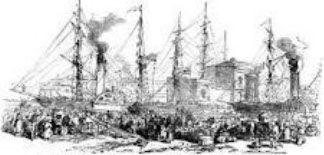



Sligo was one of the principal ports of emigration on the west coast.
In the period 1847 - 1851 an estimated 17,943 people sailed from Sligo to Canada, but one particular voyage ended in terrible loss of life.
In March 1847 the famine ship Carrick of Whitehaven, sailed from Sligo with 187 passengers and all went well until she entered the Gulf of St. Lawrence on the 28th of April. It was near the end of her voyage when she encountered a sudden storm and due to ice in the rigging the crew were unable to shorten sail. The vessel was blown onto rocks close to the little settlement of Cap de Rosiers Gaspé and broke up quickly.
118 crew and passengers were drowned while the survivors were rescued by local fishermen. In the days that followed 87 bodies were washed ashore and were buried in a mass grave over which an imposing monument, in the shape of a cross, was erected to their memory.
Most of the survivors of that awful tragedy settled on the Gulf of St. Lawrence where their descendants can still be traced by their distinctive Irish surnames.
In 1900, St. Patrick’s Parish in Montréal offered the Carricks Monument to the Cap-des-Rosiers parish church in memory of those who died. Later, in 1966, the ship’s bell was found far away in Blanc Sablon and enshrined in a small monument next to the original one. A plaque, put in place in 1977 by the Canadian Parks Service, recalls this tragedy. It is located in the north sector of Forillon National Park.














